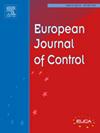Efficient reduction of interconnected subsystem models using abstracted environments
IF 2.6
3区 计算机科学
Q2 AUTOMATION & CONTROL SYSTEMS
引用次数: 0
Abstract
We present two frameworks for structure-preserving model order reduction of interconnected subsystems, improving tractability of the reduction methods while ensuring stability and accuracy bounds of the reduced interconnected model. Instead of reducing each subsystem independently, we take a low-order abstraction of its environment into account to better capture the dynamics relevant to the external input–output behaviour of the interconnected system, thereby increasing accuracy of the reduced interconnected model. This approach significantly reduces the computational costs of reduction by abstracting instead of fully retaining the environment. The two frameworks differ in how they generate these abstracted environments: one abstracts the environment as a whole, whereas the other abstracts each individual subsystem. By relating low-level errors introduced by reduction and abstraction to the resulting high-level error on the interconnected system, we are able to translate high-level accuracy requirements (on the reduced interconnected system) to low-level specifications (on abstraction and reduction errors) using techniques from robust performance analysis. By adhering to these low-level specifications, restricting the introduced low-level errors, both frameworks automatically guarantee the accuracy and stability of the reduced interconnected system. We demonstrate the effectiveness of both frameworks by applying them to a structural dynamics model of a two-stroke wafer stage, achieving improved accuracy and/or greater reduction compared to an existing method from literature.
使用抽象环境有效地减少相互关联的子系统模型
提出了两种保持结构的互联子系统模型阶数约简框架,提高了约简方法的可追溯性,同时保证了约简后互联模型的稳定性和精度边界。我们没有独立地简化每个子系统,而是考虑了其环境的低阶抽象,以更好地捕获与互联系统的外部输入输出行为相关的动态,从而提高了简化的互联模型的准确性。这种方法通过抽象而不是完全保留环境,大大降低了减少的计算成本。这两个框架在生成这些抽象环境的方式上有所不同:一个将环境抽象为整体,而另一个则抽象为每个单独的子系统。通过将由简化和抽象引入的低级错误与互连系统上产生的高级错误联系起来,我们能够使用来自健壮性能分析的技术将高级精度需求(在简化的互连系统上)转换为低级规范(在抽象和简化错误上)。通过遵守这些低级规范,限制引入的低级错误,这两个框架自动保证了简化互联系统的准确性和稳定性。我们通过将这两种框架应用于二冲程晶圆级的结构动力学模型来证明它们的有效性,与文献中的现有方法相比,实现了更高的精度和/或更大的降低。
本文章由计算机程序翻译,如有差异,请以英文原文为准。
求助全文
约1分钟内获得全文
求助全文
来源期刊

European Journal of Control
工程技术-自动化与控制系统
CiteScore
5.80
自引率
5.90%
发文量
131
审稿时长
1 months
期刊介绍:
The European Control Association (EUCA) has among its objectives to promote the development of the discipline. Apart from the European Control Conferences, the European Journal of Control is the Association''s main channel for the dissemination of important contributions in the field.
The aim of the Journal is to publish high quality papers on the theory and practice of control and systems engineering.
The scope of the Journal will be wide and cover all aspects of the discipline including methodologies, techniques and applications.
Research in control and systems engineering is necessary to develop new concepts and tools which enhance our understanding and improve our ability to design and implement high performance control systems. Submitted papers should stress the practical motivations and relevance of their results.
The design and implementation of a successful control system requires the use of a range of techniques:
Modelling
Robustness Analysis
Identification
Optimization
Control Law Design
Numerical analysis
Fault Detection, and so on.
 求助内容:
求助内容: 应助结果提醒方式:
应助结果提醒方式:


